Introduction: Why Study Egyptian Mathematics?
The history of mathematics contains Egyptian mathematics as one of its earliest documented mathematical systems. The practical requirements of Nile River life led to the development of this mathematical system more than 4,000 years ago. The annual Nile River floods destroyed all land boundaries, which required farmers to measure their properties once more. Temple and pyramid builders needed to determine angles and weights for their construction projects, while traders and officials maintained detailed records of goods and taxes, and labor expenses.
The practical nature of their environment led ancient Egyptians to develop straightforward mathematical approaches. The Egyptian mathematical system included decimal number systems and unique fraction writing methods, along with geometric tools for measuring area and volume, as well as calculating slopes. The mathematical system served as a practical tool that supported agricultural operations, construction activities, and administrative work.
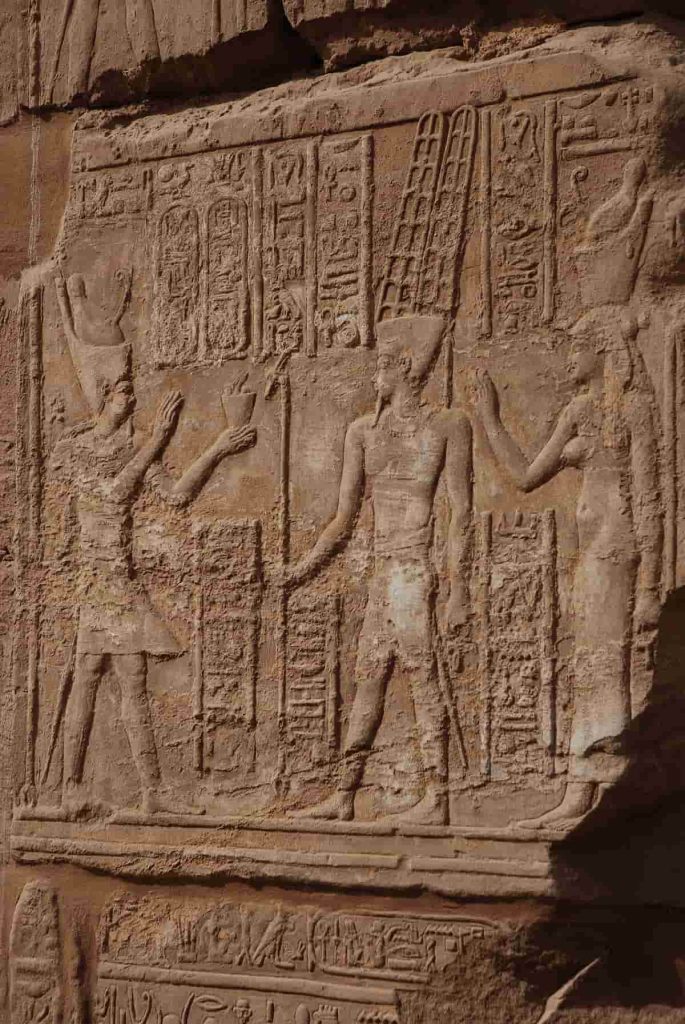
photo of rock, wood,
The early Egyptian mathematicians who functioned as skilled scribes maintained and documented mathematical knowledge through papyrus scrolls. The religious tradition of mathematics existed through its connection to Seshat, who represented writing and measurement, and architectural skills.
The study of Egyptian mathematics reveals more than basic historical information. The Ancient Egyptian civilization used numerical and geometric solutions to resolve daily challenges, which established fundamental principles that shaped subsequent cultures and continue to define human advancement.
Origins and Everyday Roots in Egyptian Mathematics
Early Counting Tools
The first recorded evidence of mathematics in ancient Egypt dates back to 3200 BC. The earliest evidence of Egyptian mathematics appears in small counting tools and inscriptions that include ivory labels from Abydos and hieroglyphs on the Narmer Macehead. Early records indicate that Egyptians maintained consistent methods for tracking numbers and resource management, and quantity measurement. The system developed by Egyptians during this period would transform into the mathematical framework that we recognize today as Egyptian mathematics.
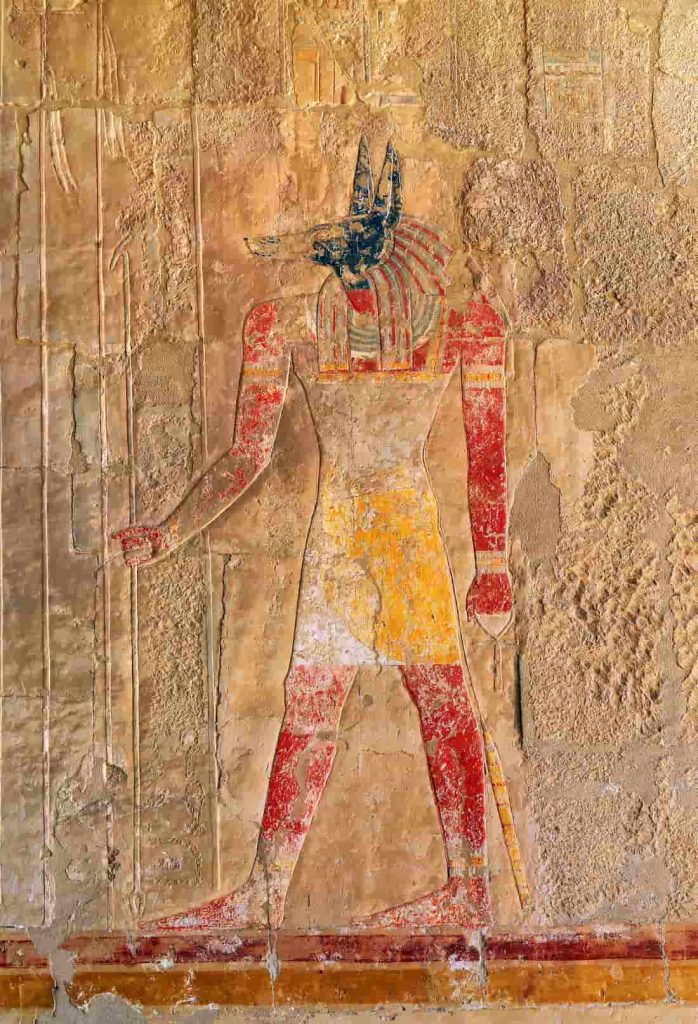
Ancient Egypt color image of Anubis on the wall in Luxor
Agriculture, Trade, and Taxation
The fundamental reason for early mathematical development stemmed from the everyday activities of people living along the Nile River. Agriculture requires careful planning. The annual river floods modified the geographical extent of agricultural land each year. Farmers required precise land measurement techniques to achieve fair crop distribution and tax calculation. The need for accurate counting and measurement techniques emerged as a direct result of this situation.
The construction of buildings needed mathematical knowledge. The construction of temples and tombs, and later pyramids, required exact measurements. The builders used geometric calculations to determine surface areas and volumes, and slopes, which guaranteed stability for their large constructions. Basic mathematical skills served as the foundation for both furniture creation and container production.
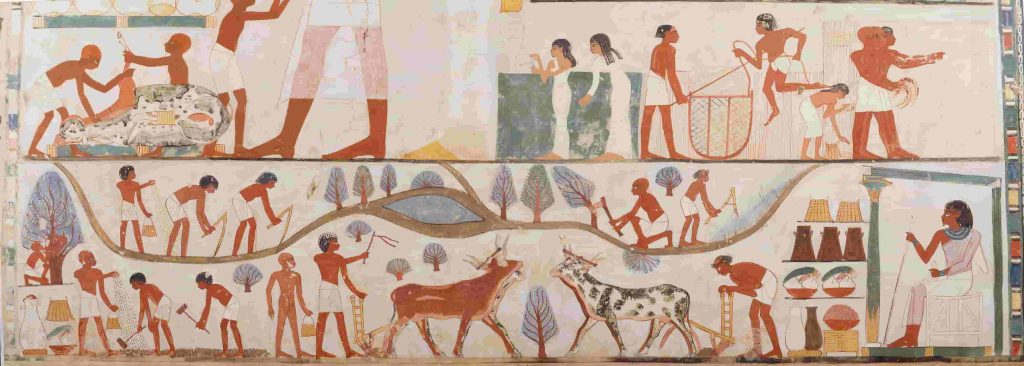
Egyptian Agriculture
Development of Arithmetic and Geometry
The development of early Egyptian mathematics received additional momentum from trade activities and taxation systems. The operations of merchants and officials required them to maintain accurate records of goods and process payments, and distribute supplies efficiently. The trained scribes established the first formal arithmetic system and practical problem-solving methods through their record-keeping activities.
The development of ancient Egyptian mathematics emerged directly from the requirements of everyday life. The mathematical system functioned as a practical instrument that maintained its connection to agricultural practices and construction activities, and commercial transactions. The necessary combination of observation with practical needs resulted in the development of a number system and counting method, and problem-solving techniques, which served as the foundation for centuries of practical mathematics.
Egyptian Number System Explained
Hieroglyphic Numerals
The Egyptian number system emerged as one of the first systematic methods for counting and recording numbers during ancient times. The system they used operated through addition instead of the positional system, which we employ today. The system used hieroglyphic symbols for each power of ten and required users to repeat these symbols according to the number’s requirements. The number 276 required two hundred symbols combined with seven tens and six ones. The position of symbols in the written text did not affect the numerical value, but scribes commonly placed larger symbols first to enhance understanding.
Hieratic Script for Daily Calculations
The Egyptians employed hieratic script as a practical writing system that served as a faster and more simplified alternative. The hieratic numeral system enabled scribes to write numbers on papyrus efficiently when performing tasks such as trade transactions and tax documentation, and construction planning. The administrative and accounting sector employed hieratic numerals extensively to make early Egyptian mathematical calculations accessible for everyday use.
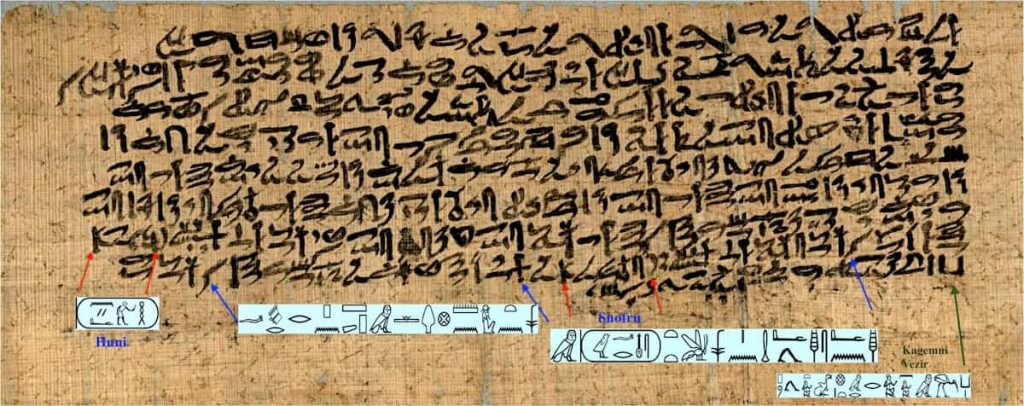
Papyrus Prisse
Counting Large Numbers and Fractions
The ancient Egyptians used counting methods that went beyond basic whole number systems. The Egyptians created specific techniques to express fractions by adding together unit fractions, which always had a numerator value of one. The “eye” symbol from the Eye of Horus, along with other special notations, enabled them to express grain divisions and bread portions, and other quantities with exactness.

Edfu Egyptian Numerals
The number system provided practical solutions to mathematical problems. The Egyptian numerals, along with their arithmetic methods, enabled calculations for field area measurements and storage container volume assessments, and pyramid slope determinations. Through the combination of power-of-ten symbols and repeated addition, they could solve both large number problems and complex mathematical operations.
The organized number system demonstrates that ancient Egyptian mathematics operated with a strong functional purpose. The system functioned to resolve actual problems in Nile River agriculture and trade, and construction, while establishing a base for practical record-keeping and sophisticated calculations.
Egyptian Fractions and the Eye of Horus
Unit Fractions and Fraction Tables in Egyptian Mathematics
In ancient Egyptian mathematics, fractions operated according to different principles than modern mathematical approaches. The Egyptians employed unit fractions as their main mathematical tool because their numerators always equaled one. The Egyptians expressed 3/4 as the combination of 1/2 and 1/4 instead of writing it directly. The system enabled scribes to divide resources, including grain and bread, and beer, into precise portions for workers and households, and temples.
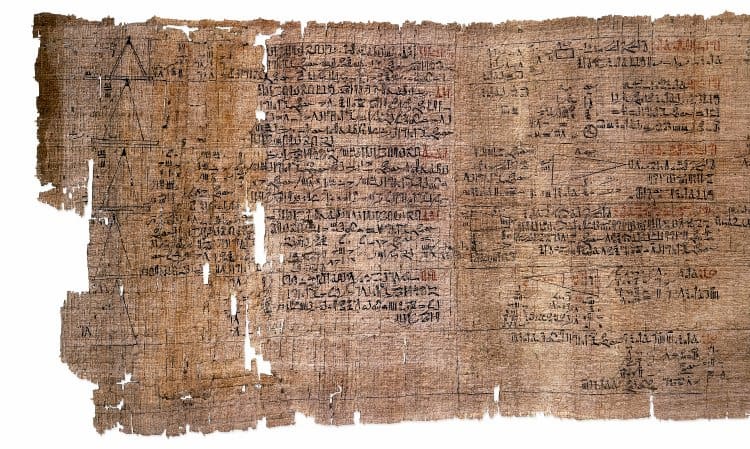
Rhind Mathematical Papyrus
The Egyptians developed tables that showed how to transform fractions into unit fractions for easier calculation purposes. The Rhind Mathematical Papyrus contains one of the most well-known examples, which demonstrates food division problems and field measurement, and wage distribution tasks. The tables enabled scribes to perform calculations with both consistency and precision.
Eye of Horus as a Fraction Symbol
The Eye of Horus served as a visual representation system for Egyptian fractions. The Eye served dual purposes in mythology as a symbolic representation while also functioning as a visual system to express fractional parts of a complete unit. The different parts of the eye represented various fractional values starting from 1/2 down to 1/64. The system proved essential for measuring grain and religious rituals and offerings because it connected practical mathematical operations to cultural beliefs.
Fractions in Construction and Food Distribution
The practical use of Egyptian fractions extended beyond everyday transactions because they supported architectural calculations. The use of fractional units enabled builders to establish proportions while measuring slopes and dividing areas precisely. Through their use of unit fractions and symbolic representations, scribes could perform division and multiplication problems without modern mathematical notation, which made their methods both functional and adaptable.
The study of Egyptian fractions demonstrates that ancient Egyptian mathematics maintained strong ties to practical applications in trade and construction, and everyday life. The approach demonstrates how early mathematicians used creative precision to solve practical problems.
Mathematical Texts and Papyri of Ancient Egypt
Rhind Mathematical Papyrus
Most of our knowledge about Egyptian mathematics derives from existing written texts and papyrus documents. The documents demonstrate that mathematics functioned as an organized system that people used throughout their daily activities. The Rhind Mathematical Papyrus stands as the most vital source because the scribe Ahmes transcribed it in 1650 BC. The papyrus contains 84 practical problems which cover arithmetic and fractions and geometry, and volume. The document contains tables for transforming fractions into unit fractions, which serve as an essential historical record of ancient Egyptian mathematical operations.
Moscow Mathematical Papyrus and Others
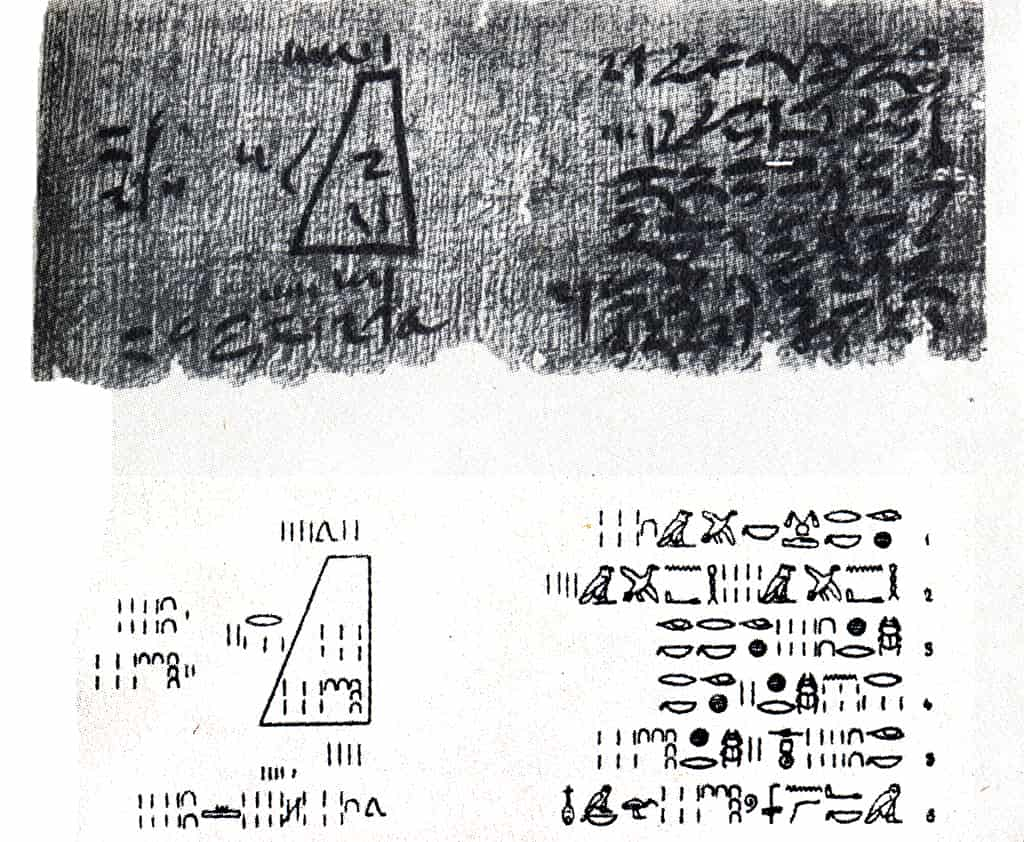
Moscow Mathematical Papyrus
The Moscow Mathematical Papyrus stands as an important document that researchers believe originated around 1850 BC. The document emphasizes geometric calculations that scribes applied to compute areas and volumes, and slopes for building projects, including pyramid construction. The Berlin Papyrus, together with the Akhmim Wooden Tablets and the Mathematical Leather Roll, represent important sources among others. The texts demonstrate actual problems that involved bread distribution and field measurement, and building quantity determination.
Hieroglyphic vs. Hieratic Recording
The scribes employed hieroglyphic and hieratic scripts to write these mathematical texts. Hieroglyphs served official purposes in monuments and official records, but hieratic provided a faster script for papyrus calculations. The dual writing system enabled mathematics to fulfill administrative requirements and practical applications.
They demonstrate how Egyptian mathematicians conducted their work. The lack of personal names in the texts does not diminish the evidence of advanced mathematical abilities because the detailed problem-solving methods demonstrate high levels of skill. The scribes demonstrated mastery of mathematics through their ability to perform calculations for trade activities and taxation and construction, and religious ritual, thus proving that mathematics was vital to ancient Egyptian society.
Egyptian Geometry and Building Pyramids
Measuring Land and Construction
The practical requirements of construction formed a direct connection between geometry and ancient Egyptian society. The construction of temples and tombs, and pyramids required builders and architects to use exact measurements for their designs. The Egyptian geometric approach focused on practical solutions for measuring land areas and calculating slopes, and determining dimensions.
Seked and Pyramid Slopes
The seked represented a fundamental concept that described pyramid slope measurements. The seked system provided builders with a method to determine horizontal distances for each vertical height which enabled them to construct large structures with uniform angles. The 3-4-5 triangle served Egyptian architects as a tool to create right angles, which ensured both stability and accuracy in their building projects.
Right Angles and Geometric Tools
The measurement principles used for fields and storage containers, and simple building projects, remained consistent. Surveyors and scribes documented their calculations through hieroglyphic and hieratic scripts with great attention to detail. The calculations allowed them to find the areas of rectangular and triangular plots and the volumes of granaries and stone blocks, as well as the proportions needed for ramps and walls.
The practice of geometry maintained a connection with religious rituals. The temple and pyramid construction followed star alignments, including Sirius, which demonstrated how mathematical concepts merged with astronomical observations and religious ceremonies. Measurement and proportion served both functional and symbolic purposes.
Egyptian mathematicians achieved a wide range of solutions by uniting arithmetic operations with geometric principles, which addressed both everyday land measurements and massive construction projects. The mathematical procedures of ancient Egypt depended on straightforward, systematic methods that demonstrated both practicality and precision in their mathematical approaches.
The study of Egyptian geometry demonstrates how early mathematicians used numbers and shapes to solve real-world problems which became the basis for future mathematical and architectural progress.
Everyday Uses of Mathematics in Egypt
Agriculture and Flood Management

Nile River
The practical application of mathematics in ancient Egypt skipped theoretical understanding because it served as a functional instrument for everyday needs. The people of Egypt, including farmers together with builders, traders, and officials, depended on arithmetic and geometry to manage their resources near the Nile River. The annual floods modified field boundaries, thus requiring precise measurement methods. Surveyors employed basic geometric methods together with Egyptian number systems to establish fair land divisions while determining agricultural tax obligations.
Food Distribution and Trade
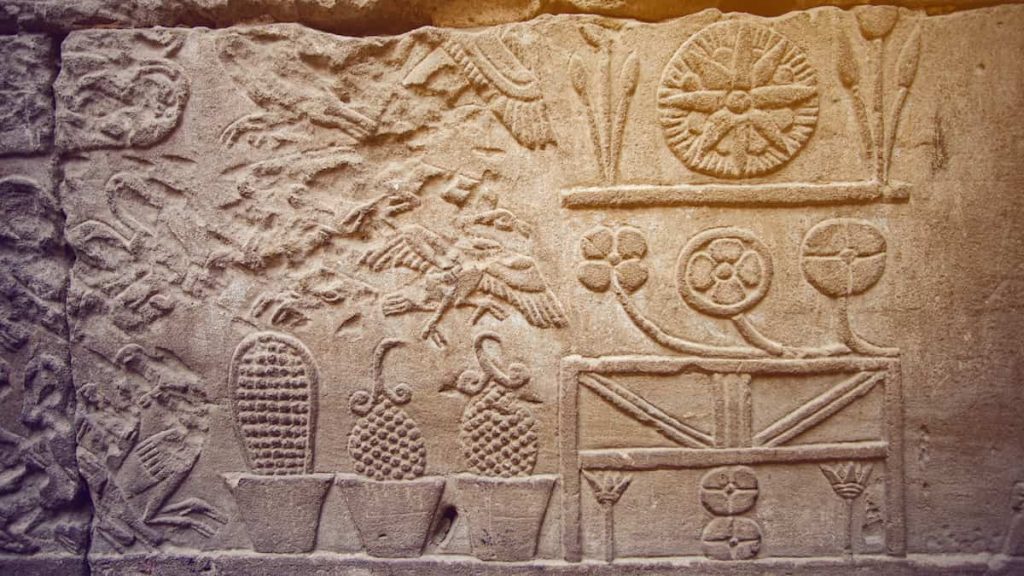
Food in Ancient Egypt
The distribution of food required mathematical calculations to function properly. The temple personnel and workers received their correct rations through the precise measurement of grain, bread, and beer. Scribes used unit fractions to perform exact resource division, which avoided both resource shortages and disputes. The administration needed mathematical precision for accurate addition and subtraction, and multiplication operations to manage labor and supply records effectively.
Trade and commerce also depended on math. Merchants used weights for measurement while performing price calculations and unit conversions to maintain fair business deals. The measurement and calculation process was essential for both small-scale tool and container production. Scribes used hieratic script to document transactions and resources, which produced detailed records that supported organizational stability in both temple and town operations.
Calendar and Religious Calculations
The mathematical principles of Egypt influenced both their cultural practices and religious beliefs. The agricultural cycle and religious festivals depended on calendar calculations because the 365-day year tracked the appearance of Sirius in the sky. The construction of temples and monuments required precise geometric planning to achieve structural stability and celestial event alignment.
The everyday life of ancient Egyptians demonstrates how mathematical concepts, including numbers and fractions, and geometric principles became integral to their daily activities. The Nile civilization operated efficiently through mathematical solutions, which supported farming activities and building construction as well as trade operations and religious ceremonies. The practical applications of early Egyptian mathematics prove that the system was both essential and advanced in its time.
Early Number Theory Knowledge
Prime, Composite, and Perfect Numbers
The majority of ancient Egyptian mathematical work focused on practical applications, yet scribes demonstrated knowledge of number patterns. The Egyptian scribes demonstrated advanced mathematical understanding through their identification of prime numbers alongside composite numbers and perfect numbers, which indicated their mathematical knowledge extended past basic counting and measurement. The early number theory system served primarily to help scribes perform calculations and solve everyday problems efficiently.
Doubling, Halving, and Multiplication
The Egyptian scribes employed unit fractions in their work by dividing numbers into fractions with a numerator of one. The consistent practice of this method required scribes to understand how numbers relate to each other and their divisibility properties. The doubling and halving approach to multiplication and division operations demonstrated that Egyptian scribes thought logically about numbers instead of using random trial-and-error methods.
Geometric Calculations and Patterns
The process of geometric calculations sometimes depended on recognizing mathematical patterns in numbers. Scribes who measured areas and volumes used formulas containing whole numbers and fractions, which predicted mathematical concepts that would develop into formal systems later. The combination of arithmetic with fractions and geometry reveals that Egyptian scribes had a practical grasp of number properties.
The Egyptians lacked a structured method for proving theorems, yet their written records demonstrate both careful observation and systematic approaches. Historical analysis of the Rhind and Moscow Papyri reveals that early Egyptian mathematicians understood number properties that they applied to practical problems.
Famous Egyptian Mathematics
Ahmes and the Rhind Papyrus
Let me tell you that Egyptian mathematics, as in most other cultures of the ancient world, may be classified more as a tradition than a field of academic inquiry involving individual effort. At the same time, some well-known individuals made much, such as Ahmes, the copyist of the Rhind Papyrus in 1650 B.C. The work of Ahmes preserved several problems and their solutions, thus making him one of the earliest Egyptian mathematicians known to the world.
Imhotep and Architectural Mathematics
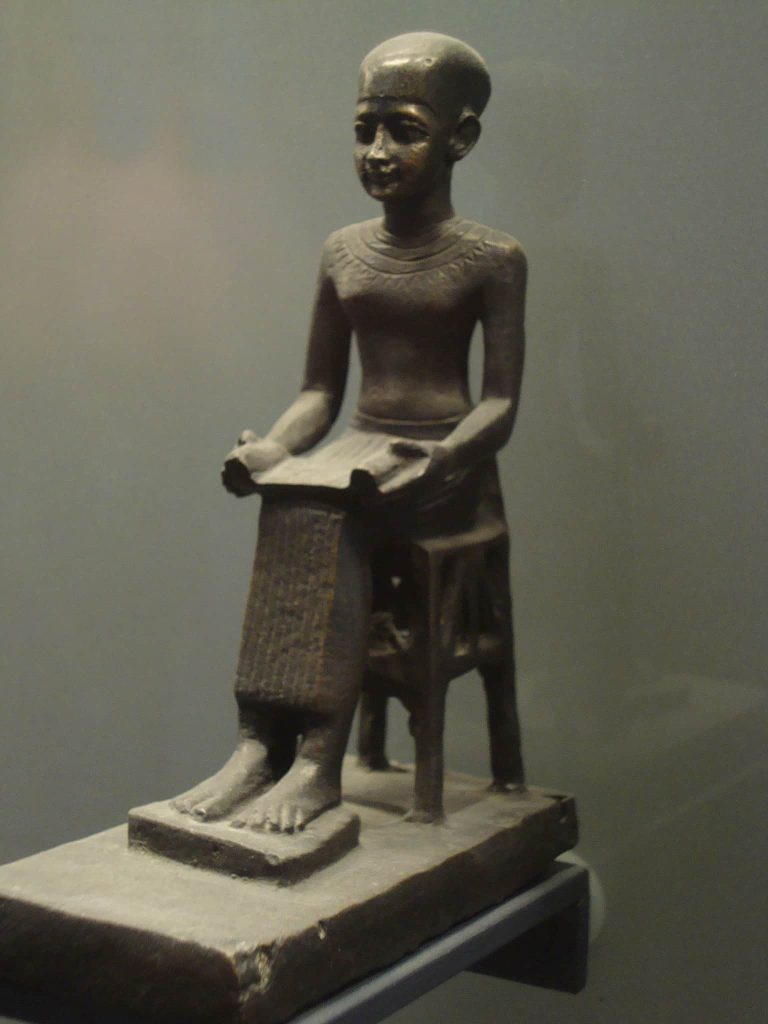
Imhotep
Also, thanks to a person we can talk about today – to Imhotep, the architect and builder of the austere Step Pyramid of Saqqara. Certainly, he was an expert regarding building design and construction; however, within this scope, Imhotep’s scientific interest used to address geometry and measurement questions, which influenced together with other factors, also influenced other mathematical disciplines in Egypt.
Later Scholars and Legacy
There exist other names in the historiography, as well as Ankh-haf, who counted the volume of a truncated pyramid, and Amenemhat, who is famous for his empirical method of calculating the area of the circle. These mathematicians used in practice calculations; they used arithmetic, fractions, as well as geometry of figures, land surveying, and construction design.
During the time of the Ptolemies, Greek mathematicians were able to work harmoniously with their Egyptian counterparts, such as the great Geographer, Ptolemy, to develop the mathematics and astronomy of their age. Many years later, great accuracy in calculations was shown by the Egyptian mathematician Ibn Yunus, who made dated tables of complex numbers that are preserved to this day.
Even though there were few Egyptian mathematicians documented when compared to the later centuries, sources show that they were able to render amalgams of caution and information amongst their skills. They built a base for the future corkboard quite naturally, and later, built a foundation for arithmetic properties, fractions, and geometry that traveled from the matrices to the west.
Egyptian Goddess of Mathematics: Seshat
Seshat and Measurement Tools
The Egyptian people used mathematics for practical needs while connecting it to their religious beliefs during ancient times. The goddess Seshat maintained a strong connection to writing and measurement and architecture, and record-keeping. The pharaohs received assistance from Seshat during the “stretching the cord” ceremony, which determined temple and pyramid construction layouts and alignments. The ritual demonstrates how Egyptian religious practice is directly linked to mathematical principles, which established the base of sacred architecture. Through her dual roles as “Mistress of the House of Books” and “Lady of Builders,” Seshat supervised the development of exact records and maintained the accuracy of construction and land division calculations.

Seshat, goddess of knowledge and writing
Her role also extended to astronomy. Through her work, Seshat enabled the tracking of celestial occurrences, which helped people schedule agricultural seasons and religious celebrations. Through her work, Seshat became the central figure of Egyptian number and geometry practices by uniting practical measurement with symbolic meaning.
Religious and Cultural Significance
The worship of Seshat demonstrates that mathematics in ancient Egypt existed as an essential part of everyday life and governmental operations, and religious traditions. Scribes and builders viewed mathematics as a sacred skill because it maintained both efficiency and order in their work. The study of Seshat and her number connections demonstrates the deep cultural value of Egyptian mathematics and its integration into both functional and ritual activities.
Conclusion
The mathematical practices of Egypt focused on practical applications while maintaining precise calculations, which directly supported daily activities in the Nile region. The early Egyptian mathematical system addressed practical needs through its solutions of real-world problems and its application to religious and administrative tasks. The system involved scribes and architects and the goddess Seshat, which demonstrated the combination of cultural and skilled practices. The mathematical methods developed by ancient Egyptians shaped both Greek and subsequent civilizations to create enduring mathematical contributions throughout history. The study of their mathematical work demonstrates how necessity combined with observation and creativity formed one of the earliest mathematical traditions in the world.











